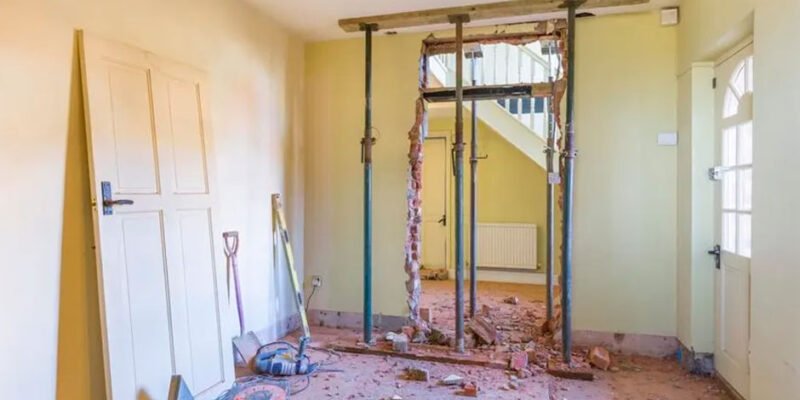Introduction
In the realm of home improvement, the prospect of tearing down walls is often met with a mix of excitement and apprehension. This article delves into the intricacies of load bearing wall removal, shedding light on the cost factors, considerations, and choices that homeowners face when contemplating such a project.
Understanding the Cost of Wall Removal
Homeowners embarking on a journey to transform their living spaces need to grasp the diverse factors influencing the cost of wall removal. In 2023, the expense associated with knocking down an interior wall can vary widely, ranging from $400 to $13,000. The price spectrum hinges primarily on whether the wall in question is load-bearing or non-load-bearing. However, an array of additional elements, such as the home’s stories, plumbing, and electrical infrastructure concealed within the wall, contribute to the overall expense. On average, entrusting this task to a professional will cost around $3,100.
Wall Removal and Its Nuances
The complexities of wall removal go beyond the surface, delving into the realm of structural intricacies and material considerations. The total cost of wall removal is predominantly comprised of labor expenses, which naturally fluctuate based on the cost of living and local labor rates. Yet, the crux of the matter lies in the contents and composition of the wall itself. Different materials pose different challenges; for instance, stone walls necessitate more time and effort to remove compared to drywall.
Calculating Wall Removal Costs
The cost of wall removal can be dissected to provide a clearer picture of the financial aspects. The price typically ranges from $0.40 to $6.40 per square foot, contingent on the materials used in the wall. Additionally, factors like pipes, insulation, wiring, and even hazardous materials contribute to the overall cost calculation. Of paramount significance is the fact that removing a load-bearing wall, which supports integral structures in a home, incurs higher expenses.
Wall Removal Cost Breakdown
- Average Cost: $3,100
- Highest Cost: $13,000
- Lowest Cost: $400
Cost Variation by Wall Type
The type of wall plays a pivotal role in determining the expenses involved in its removal. For homeowners considering substantial renovations requiring wall removal, seeking the expertise of a general contractor is often advisable. These professionals are adept at discerning whether a wall is load-bearing or non-load-bearing, as well as evaluating its significance in multi-story homes. Typically, such information can be gleaned from the original home plans.
Non-Load-Bearing Wall Removal
Removing a non-load-bearing wall, spanning 80 to 120 square feet, falls within the range of $400 to $2,500 on average. This cost accounts for dismantling a basic section of drywall devoid of insulation, plumbing, or extensive wiring. Nonetheless, such walls may still require the involvement of specialists like plumbers or electricians to ensure a safe removal process. Unlike load-bearing walls, these are simpler to remove and don’t necessitate additional structural engineering.
Load-Bearing Wall Removal
The scenario shifts when dealing with load-bearing walls. These walls uphold the structural integrity of a home and cannot be removed without introducing new support systems. The removal cost varies based on the weight borne by the wall. For instance, in single-story homes, the cost ranges from $1,400 to $3,000, contingent on the type of support beams chosen. The expenses increase for multi-story homes, ranging from $3,200 to $13,000, where temporary and permanent support beams become imperative. In such cases, the expertise of a structural engineer is essential to ensure safety.
Factors Amplifying Costs
Beyond the foundational considerations, several supplementary factors amplify the cost of wall removal:
Utility Line Relocation
Incorporating utility lines such as wires, pipes, or gas lines into wall removal can elevate costs by $1,000 to $5,000. Electricians charge around $50 to $150 per hour, while plumbers fall within the range of $45 to $200 per hour. Obtaining permits for major utility relocations further compounds the expenses.
Wall Material Complexity
Different wall materials entail varying costs for removal. Materials like drywall or wood are more straightforward and cost around $0.30 to $0.60 per square foot to remove. In contrast, more intricate materials like masonry, such as concrete or brick, can drive costs up to $6.40 per square foot due to the additional time and tools required.
Junk Removal and Hazardous Materials
Contractors might include the cost of removing discarded wall materials in their pricing, averaging around $225. The presence of hazardous materials like lead paint or asbestos insulation necessitates specialized removal, increasing costs.
Permits and Finishes
Structural changes, especially those involving load-bearing walls, often mandate building permits, which average around $200. Finishing aspects, such as drywall installation and painting, add further to the overall expenses.
Wall or Beam Replacement
Choosing not to replace the wall demands the installation of a support beam, ranging from $500 to $4,000 including labor. Different materials like wood, steel, engineered lumber, and poured concrete beams entail varying costs per linear foot.
Professional vs. DIY Approach
While taking on small elements of the project independently might be feasible, entrusting the removal of load-bearing walls to professionals is paramount. Unless certain of a wall’s non-load-bearing nature and absence of utility lines, a DIY endeavor risks compromising the structural integrity of the home. However, post-removal tasks like patching, painting, and clean-up can be tackled by homeowners.
Conclusion
The realm of load-bearing wall removal is fraught with intricate considerations, from material intricacies to structural implications. Homeowners venturing into such projects must weigh costs, seek professional input, and navigate a multitude of factors to achieve successful transformations. The expense of wall removal is influenced by an array of variables, ultimately shaping the journey of turning structural changes into a reality.
















Comments